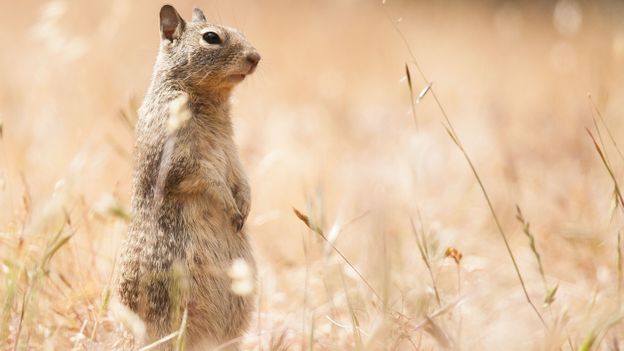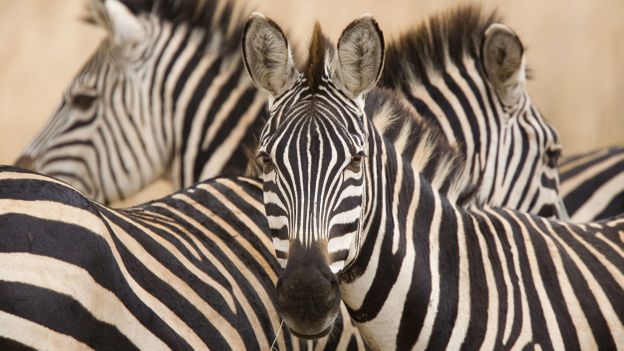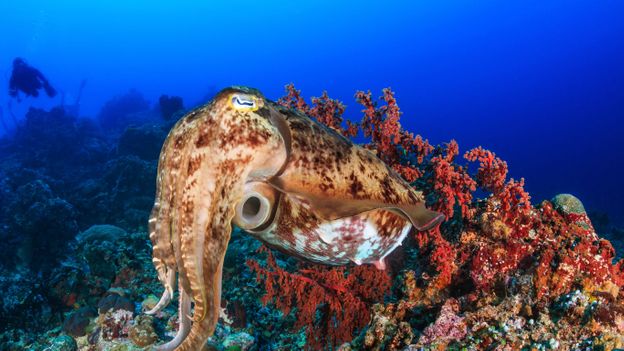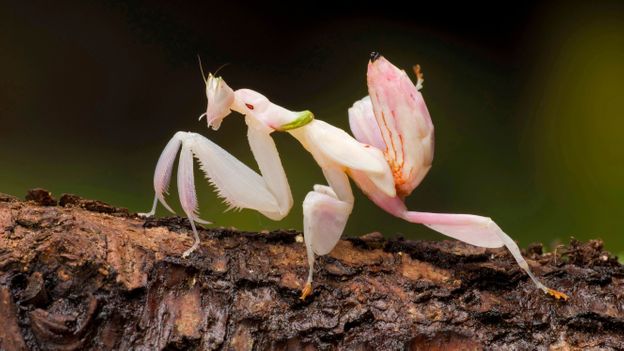Magical illusions, devious deceptions, and flamboyant costumes – meet the best animal tricksters on Earth
Californian ground squirrel
This endearing little rodent faces a large problem. Equally at home on a rocky outcrop, or deep in a valley, it frequents the grasslands and open woodlands of California, Western Nevada and Western Oregon in the US. However, due to the open nature of their habitat, these rodents are highly vulnerable to predation.
One enemy is the rattlesnake, a deadly serpent that hunts by smell, and once locked onto a scent trail there is seemingly no escape for its victim.
But Californian ground squirrels have a distinctly sneaky way to fool their mortal enemy. They have learnt that by rubbing themselves with the shed skin of a rattlesnake, they can mask their own scent with that of the snake’s.
It is thought this learned behaviour has been passed from squirrel to squirrel, with “eau de snake” becoming the essential perfume of choice for any discerning ground squirrel.
Zebra
“Why do zebras have stripes?” is one of the oldest questions in evolutionary biology, troubling scientists ever since Charles Darwin and Alfred Russel Wallace first disagreed on the subject. But research now claims that these stripes function as a form of “motion camouflage” acting to keep zebras safe from their enemies.
I’ve been studying animal vision for a number of years now and became quite interested in what the zebra’s stripes might be doing to the visual systems of their main predators
But how can that be true when they seemingly stick out like sore thumbs? Well, it’s all down to the most magnificent of tricks in a magician’s toolbox – the optical illusion.
Black and white are highly contrasting, and when combined they can play tricks on the mind, confusing many animals’ vision. Dr Martin How from the University of Bristol has been studying the way top predators such as cheetahs and lions see their prey.
“I’ve been studying animal vision for a number of years now and became quite interested in what the zebra’s stripes might be doing to the visual systems of their main predators,” says How.
He set out to see if zebra stripes were fooling the predators via the “wagon wheel illusion”. This is where the brain, when faced with a fast moving object like a wheel, struggles to process the movement and simplifies the interpretation of what it is seeing.
In the process, however, it tricks the mind into getting the direction entirely wrong. This is why when we see a car moving at high speed or a plane’s propellers, we occasionally perceive the wheel hubs or propeller blades to be moving slowly in reverse.
How’s research showed that as the zebras start to move as a collective herd, their stripes create an illusion called “motion dazzle”. How believes, for example, that a predator faced with this flurry of stripes would perceive the zebras to be moving to the left, when in fact they were heading to the right.
In a hunt every split second counts, so this “dazzling effect” could cause just enough confusion for the zebra to escape, making it one of the planet’s most magnificent galloping optical illusions.
Cuttlefish
Cuttlefish have had to come up with some cunning defences to avoid being eaten, and it’s a rather visually stunning tactic to boot. Instead of encasing itself in a hard shell or armoured plating, it wears a cloak of invisibility, by transforming itself entirely to match its surroundings.
Cuttlefish do this this with the help of tiny-pigmented organs called chromatophores, which are found embedded within the top layer of their skin. As the cuttlefish move between subtly different backgrounds, each individual chromatophore is pulled and stretched by muscles controlled by the brain, changing, for example, a dot into a circle of colour in an instant.
The combined effect of several million of these chromatophores operating synchronously will then enable the cuttlefish to create colour specific patterns to match its surroundings with remarkable precision. In addition to this, the cuttlefish also has the ability to change shape and texture too, meaning they can give the impression of having simply disappeared.
What makes all of these tricks even more astonishing is that cuttlefish are actually colour blind. So if they cant even see the colours they’re attempting to emulate, how do they manage such a perfect match?
A recent discovery has revealed the cuttlefish’s secret: all across their skin are cells containing opsin, a protein usually found in the retina of the eye. So with the same light detecting molecules, it is in fact the skin itself that “sees” the colour, making it arguably one of the most beautiful and smartest skins on the planet.
African lions
If it looks like a male lion, and is perceived by others to be a male lion, you would have thought it would be a male lion – but all is not necessarily as it seems. In Botswana’s Okavango Delta live just a handful of unusual lionesses, whose flowing manes and throaty, masculine roars may well be fooling their rivals.
One of these extraordinary lions is called Mmamoriri, who for all intents and purposes, looks and sounds just like a male, yet she is definitely a member of the opposite sex.
Along with four other maned lionesses, Mmamoriri is believed to possess a genetic mutation that creates an imbalance of hormones, in turn giving her a far more masculine appearance.
In lion society, it’s the males who defend their territories from rivals, on which the whole pride depends. Scientists suspect that because Mmamoriri is able to mimic a male, rival males looking for an opportunity to take over the pride may be tricked into thinking twice before taking on these lions.
If Mmamoriri’s pride can increase their territory because of this perceived high ratio of males, then it could also increase the pride’s survival chances, leading to mutation forming the start of a new and very devious strategy.
Orchid mantis
The rainforests of Malaysia not only contain a vast array of winged insects, but also a huge variety of invertebrate predators keen to take advantage of this aerial buffet. Featuring on so many menus has meant that if these insects are to avoid being snapped up they have had to evolve to be lightning fast, agile, and very difficult to catch.
Keen to avoid the jaws of predators, these insects, however, are simply unable to resist any brightly coloured flowers designed to draw in customers from far and wide to feed on their pollen and nectar.
The orchid mantis has transformed its entire body into a beautifully sculpted and yet deceitful disguise. By becoming the perfect mimic of a flower in order to attract its prey, which it then combines with pin sharp vision and a ninja-like strike, the mantis’s sneaky tactic surely makes it one of the world’s most lethal ambush predators.
But there is even more to this “fake flower” than meets the eye. A growing mantis needs to eat every couple of days, so will need an insect to land directly within its grasp to make a successful strike unlike flowers, which can afford to play a longer waiting game.
Ever since naturalists discovered this species during Victorian times they had a suspicion that something else was happening, as the mantis seemed far more popular than the flower that it was mimicking.
Scientists have now discovered that the mantis is in fact the bigger draw due to practising the fine art of “aggressive mimicry”. It seems the insects are attracted to a flower by the brightness of its petals, and the mantis is able to contort itself not only into the perfect shape, but also a far brighter colour than any flower being mimicked.
Once fooled into visiting the mantis’s dazzling yet ruthless trap, there is no escape from this martial arts master.
Credit: Source link




